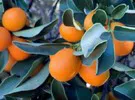The atmospheric river rains that have hit California this week are, for the moment, halting the harvest of our kumquats. “Kumquats cannot be picked when it’s raining because they have tiny pores which can absorb the surface dust into the skin of the fruit, causing the fruit to rot in a few days,” says Matt Pfeffer of Fresh Fruit Sales Nevada. “We have had substantial rain today and yesterday and the rain has impacted our ability to harvest so the crop is somewhat short in the marketplace. However the turnaround is fast on kumquats meaning as soon as the fruit is absolutely dry, we can start to harvest again.”
 Southern California production is about midseason--production generally begins in January and runs through June. The harvest also takes place in the California desert region from September to December. Kumquats now come in from Chile as well. In general this year, Pfeffer says his volume is up about 10 percent over last year due to its proprietary growing practices.
Southern California production is about midseason--production generally begins in January and runs through June. The harvest also takes place in the California desert region from September to December. Kumquats now come in from Chile as well. In general this year, Pfeffer says his volume is up about 10 percent over last year due to its proprietary growing practices.
Strong demand for kumquats
Meanwhile, demand for kumquats is good--enough to warrant year-round demand, which could be in part can be attributed to the nutritional benefits of the fruit.
 However, the industry is seeing a growing problem. “We compete with uncertified growers and shippers and it is an increasing problem for certified kumquat growers. The uncertified growers can charge less for their fruit and still make a profit,” says Pfeffer. “Because of our customer's requirements, we have all of those certifications. It’s a difficult environment to deal with because it’s not important for every buying organization to buy and offer sanitized and certified fruit. We find that challenging every year until that uncertified fruit supply runs out.”
However, the industry is seeing a growing problem. “We compete with uncertified growers and shippers and it is an increasing problem for certified kumquat growers. The uncertified growers can charge less for their fruit and still make a profit,” says Pfeffer. “Because of our customer's requirements, we have all of those certifications. It’s a difficult environment to deal with because it’s not important for every buying organization to buy and offer sanitized and certified fruit. We find that challenging every year until that uncertified fruit supply runs out.”
That in turn has factored into lower pricing in the category. Pfeffer notes his pricing is like last year’s even with growing expenses up between 8-15 percent year over year due to inflation.
For more information:
Matt Pfeffer
Fresh Fruit Sales Nevada, LLC.
freshfruitllc@gmail.com
